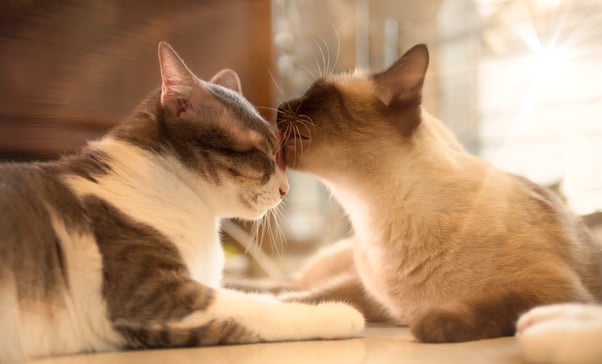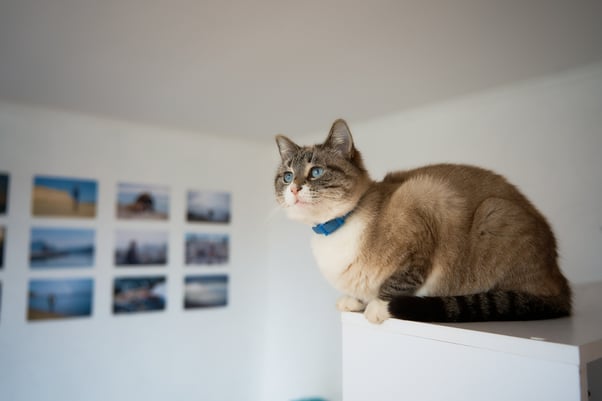Domestication & Shaping Cat Behaviour: A Happy Cat Expert Explains!
The history of cats is fascinating, and they have gone through a very unique process of domestication. Whereas dogs were intentionally bred to work beside humans, cats essentially chose to move in with us—and never left! Understanding how this progressed can give us a whole new appreciation for why cats do the things they do, and how we can meet their needs to help them thrive.
The Wild Ancestors of Domesticated Cats
The first thing to remember is cats are descended from the African Wildcat, which is a truly solitary animal. Although domesticated cats have evolved to live alongside humans, this solitary streak still remains and shapes their behaviour in different ways.
Importantly, the history of cat domestication means they have not developed many behaviours to allow them to visually communicate with other cats. For example, they don’t show appeasement behaviours in the same way dogs do—or if they do, they are much more subtle, and we don’t fully understand them yet. This means that domesticated cats tend to avoid face-to-face communication if they can, preferring to communicate via scent and pheromones instead.

The Importance of Scent in Feline Relationships
Leaving scent marks behind in their urine is the perfect form of long-distance communication. This allows cats to get to know other cats in the area without ever having to meet them and potentially risk a fight.
For cats they do know and do consider family, scent will be hugely important here too. Pairs or groups will groom one another, face and body rub against each other, and sleep in the same beds. This ensures they will naturally share the same smell and will feel safe and reassured when they are together.
You can see how important this is to domesticated cats when one half of a pair goes to the vets. Often, the remaining cat will hiss or growl when the other returns because they have picked up a strong clinical smell.
FELIWAY Optimum is ideal for this situation. It uses feline pheromone messages to create a calm and reassuring environment for cats.
Feline Survival Instincts and the Need for Safety
Because of their solitary ancestry, domesticated cat behaviour tends to involve hunting and eating alone. Cats are strongly motivated to keep themselves safe and to avoid stressful situations, and this avoids the risk of potentially putting themselves in danger. As an example, you may find a domesticated cat runs away when you accidentally step on their tail, rather than attacking.
This also explains cats’ tendency to gravitate to high places, such as the kitchen sides or mantle pieces. High places provide a vantage point where they can keep out of harm’s way while still keeping an eye on their territory. If you have fearful or anxious cats, adding high places into your home just for them will help build their confidence—and don’t forget your FELIWAY plugged in these areas!

The Role of Humans in Cat Domestication
During the history of cat domestication, cats began to gravitate towards human settlements after people started storing grain, attracting a steady supply of rodents. This is instrumental in cats living alongside people, as the humans appreciated the pest control and welcomed cats into the settlement.
Initially, these cats would have just been tamer versions of their wild counterparts. However, as kittens were born in or near human shelters, the process of socialization with people would begin. What’s more, if kittens have positive experiences with people between two and eight weeks of age, they will be much more settled around humans. And the process continues.
The Formation of Cat Colonies
This behaviour in early domesticated cats meant that cats were also now in close proximity to each other. They all congregated around such a concentrated food source (the rodents) instead of hunting for food over a wider area. So, they naturally began socializing with each other and forming colonies of free-living cats.

Today, we see cats in various social situations: living totally alone, living in colonies, or living with a human inside that person’s house. Not every cat is suited to each scenario, and this tends to depend on the cat’s genetics, early socialization, and the available environment.
Free-living cats will still tend to congregate around a reliable food source. This can be in towns, where members of the community will provide food for the street cats, or large colonies of cats, living in forests and other areas away from humans where they can freely hunt for themselves.
A Long Way from Full Domestication
One thing is for sure: cats are still a very long way off from being totally domesticated and losing their wild flares. This is wonderful for lots of reasons, and their wild nature is often something that appeals to many of us living with cats. For others, this is much more challenging, particularly when it comes to their innate drive to hunt wildlife, which sadly they are not able to lose in such a short period of evolution.
Are you interested in learning more about cats and their behaviour? We have a huge range of articles to explore online, plus you can sign up for our newsletter to stay in the loop with all the latest tips, guides, and info!